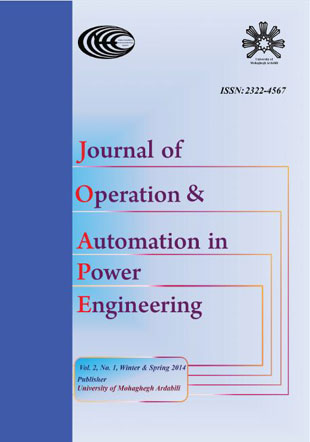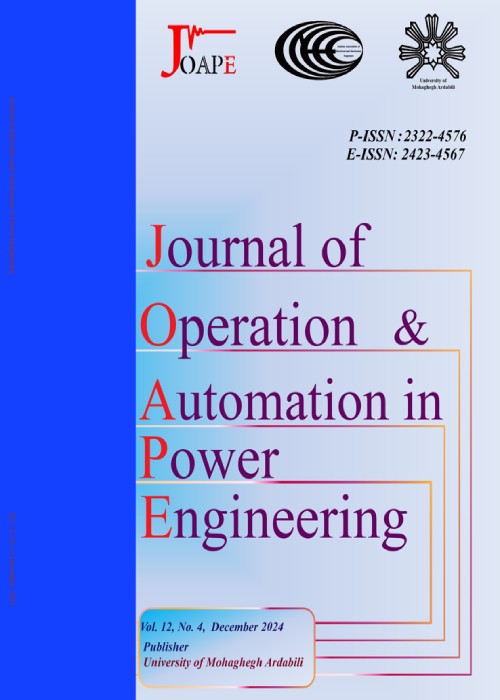فهرست مطالب

Journal of Operation and Automation in Power Engineering
Volume:2 Issue: 1, Winter - Spring 2014
- تاریخ انتشار: 1393/03/27
- تعداد عناوین: 7
-
-
Pages 1-9This paper presents an application of Benders decomposition to deal with the complexities in the simultaneous generation expansion planning (GEP) and transmission expansion planning (TEP). Unlike the power system operation fields of study, the power system planning methods are not expected to be fast. However, it is always preferable to speed up computations to provide more analysis options for the planner. In this work, Benders decomposition has been applied to solve a mixed integer linear programming formulation of simultaneous GEP & TEP. The method has been tested on two test systems: Garver 6-bus system, and IEEE 30-bus system. The results are compared to the unified solution of the problem formulation to show the consequent improvements from Benders decomposition.
-
Pages 10-21In practical situations, distribution network loads are mixtures of residential, industrial and commercial types. This paper presents a hybrid optimization algorithm for simultaneous improvement of power quality (PQ), optimal placement and sizing of fixed capacitor banks in radial distribution networks in the presence of different voltage dependent load models. The algorithm is based on combined genetic algorithm (GA)/ binary particle swarm optimization (BPSO). The objective function includes the cost of energy loss, reliability and investment cost of the capacitor banks. Simulation results for the 33-bus and 69-bus IEEE radial distribution networks using the proposed method are presented and compared with other methods. The results show that this method provides more economical solution by reducing energy loss, improving the reliability level and show a good improvement in nodes voltage to be in the requested range.
-
Pages 22-31When the distribution networks with distributed generations (DGs) are disconnected from their upstream network, network is exposed to a severe imbalance. In this case, the grid frequency drops sharply. In order to prevent damage of generators, frequency relays operate and remove DGs from the network. In spite of common methods, nowadays, keeping DG units in an islanded distribution system is proposed. Under frequency load shedding (UFLS) is one of the most important protection systems which is the last chance to prevent a system blackout following a severe disturbance occurs in a power system. In this paper, an adaptive Under Frequency Load Shedding (UFLS) method is proposed. In this algorithm priority of loads to be shed depends on type of event and loads look up table. The frequency of the Centre of Inertia (COI) is used in this method. The proposed technique applies the loads active power every few minutes which excludes the requirement of fast communication link. This method provides accurate information about the system''s total deficit value. The proposed UFLS method by shedding fewer loads can stabilize the frequency of the distribution system when it is islanded
-
Pages 32-39In this paper, a new method based on branch placement for the optimal placement of phasor measurement units (PMUs) in power systems is proposed. In this method, the PMUs may be installed on branches. The PMUs are in type of single-channel and are installed at the beginning of the branches. So, they are able to measure the bus voltages. By installing the PMUs on the branches, in the probable conditions such as line or PMU outages, the security of observablility may be increased in comparison to the bus placement method. In this paper, to solve the optimization problem the genetic algorithm (GA) method is used. The proposed method is applied to IEEE 30-bus and 24-bus case study networks. Also, the method is tested on a real 400 kV network in Iran.
-
Pages 40-48In this paper, impacts of customer tolerable repair time omission on electric distribution system reliability are investigated. Failure rate and repair time of components are usually considered to be as constant parameters in reliability evaluation. Also, failures of component are resulted from failure of operation or overloading that both are considered in this paper. However, there may be some cases that repair times of components, as random variables, are small and tolerable from customer point of view; so they may be ignored in reliability calculations. Therefore, more reasonable results will be obtained for load points and system indices, by omitting tolerable failures from calculations. A simple model of circuit breaker, but not as other components, is also considered to better analysis of system. Monte Carlo simulation method is used for calculating reliability indices. A meshed distribution system is selected as test system and simulations are performed and analyzed. Simulation results show that unavailability of load points are decreased resulting from omitting sustainable repair time and also, it is required to include breaker model in distribution reliability evaluation.
-
Pages 49-59The increasing penetration of wind turbines into electrical power systems has pushed grid operators to set new requirements for this type of generating plants in order to keep acceptable and reliable operation of the systems. The major problems of wind are the great variability of its production. The dynamic change of the wind speed returns the quantity of the power injected to a strongly variable network. In this paper, a multi-objective economic load dispatch (MOELD) model is developed for the system consisting of both thermal generators and wind turbines. Using two methods sequential quadratic programming (SQP) and particle swarm optimization (PSO), the system is optimally scheduled. The objective functions are total emission and total profit of units in this paper. The probability of stochastic wind power is included in the model as a constraint. This strategy, referred to as the here-and-now (HN) approach, avoids the probabilistic infeasibility appearing in conventional models. It is shown that, based on the presented model, the impacts of stochastic wind speed on the generated power can be readily assessed. Also a total index (TI) containing the objective functions is presented to evaluate the simulation results.
-
Pages 60-73In the past few decades, increasing growth of wind power plants causes different problems for the power quality in the grid. Normal and transient impacts of these units on the power grid clearly indicate the need to improve the quality of the electricity generated by them in the design of such systems. Improving the efficiency of the large-scale wind system is dependent on the control parameters. The main contribution of this study is to propose a sensitivity analysis approach integrated with a novel hybrid approach combining wavelet transform, particle swarm optimization and an Adaptive-Network-based Fuzzy Inference System (ANFIS) known as Wavelet-ANFIS-PSO to acquire the optimal control of doubly-fed induction generators (DFIG) based wind generation. In order to mitigate the optimization complexity, sensitivity analysis is offered to identify the unified dominate control parameters (UDCP) rather than optimization of all parameters. The robustness of the proposed approach in finding optimal parameters, and consequently achieve a high dynamic performance is confirmed on two area power system under different operating conditions.


